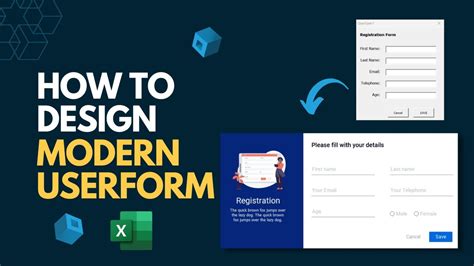Intro
Master VBA user forms with these 5 efficient methods to call and display them in your Excel applications. Learn how to show and hide forms using VBA code, including using buttons, worksheets, and modules. Discover techniques for loading forms dynamically and manipulating form controls with ease.
UserForms in VBA (Visual Basic for Applications) are powerful tools that allow developers to create custom interfaces for users to interact with their applications. Calling a UserForm, which is essentially a dialog box, can be accomplished in several ways, depending on the context and requirements of your application. Here are five common methods to call a UserForm in VBA:

1. Using the Show Method
The most straightforward way to display a UserForm is by using the Show method directly on the UserForm object. This method is typically called from a subroutine or a function within a standard module.
Sub ShowUserForm()
UserForm1.Show
End Sub
In this example, UserForm1 is the name of your UserForm. This method displays the UserForm and pauses the execution of the code until the UserForm is unloaded (closed).
2. Calling from a Button Click Event
Often, you'll want to show a UserForm in response to a user action, such as clicking a button on a worksheet or another UserForm. In the button's click event handler, you can call the Show method.
Private Sub Button_Click()
UserForm1.Show
End Sub
This approach is useful for creating interactive applications where the user's actions trigger the display of additional information or input forms.
3. Showing a UserForm Modally
By default, the Show method displays the UserForm modally, meaning that the user must interact with the UserForm before they can return to the rest of the application. However, if you want to ensure this behavior explicitly or need to make it non-modal, you can pass arguments to the Show method.
Sub ShowUserFormModally()
UserForm1.Show vbModal
End Sub
For non-modal display (allowing users to interact with other parts of the application while the UserForm is open), you can use vbModeless.
4. Calling from Another UserForm
It's common to have multiple UserForms in an application, with some acting as "sub-forms" or secondary interfaces that are accessed from a main form. Calling one UserForm from another is similar to calling it from a module or button click event.
Private Sub Button1_Click()
UserForm2.Show
End Sub
This code, placed in the code module of UserForm1, would show UserForm2 when Button1 is clicked.
5. Using a Public Subroutine
If you need to show a UserForm from multiple places within your application, it can be helpful to create a public subroutine that handles this task. This approach encapsulates the logic for displaying the UserForm in one place.
Public Sub DisplayUserForm()
UserForm1.Show
End Sub
This subroutine can then be called from any module or UserForm in your project, keeping your code organized and reusable.
UserForm in VBA Gallery










In conclusion, showing a UserForm in VBA can be accomplished through several methods, each suited to different application requirements. By mastering these techniques, you can create more interactive and user-friendly applications in Excel, Word, and other Office applications that support VBA. Whether you're a beginner or an advanced VBA developer, understanding how to effectively display and manage UserForms is crucial for building robust and engaging interfaces.
If you have any specific questions about the methods discussed here or need further assistance with your VBA projects, feel free to ask in the comments below.
